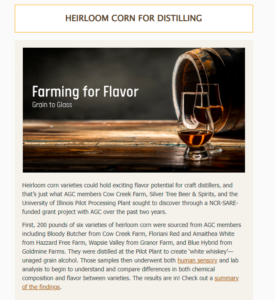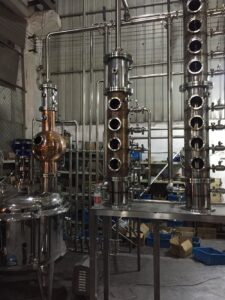Final report for FNC20-1219
Project Information
Silver Tree Beer & Spirits and Sumpy's Spirits are both farm distilleries. We raise all of the grain that we distill. We have both been raising heirloom corn varieties including Bloody Butcher, Rebellion, Wapsie Valley, and OP White.
In the United States, and particularly in the NCR-SARE region, corn is king. Specifically, yellow dent corn. This crop is used for a wide variety of products, including whisky. But is it making the best tasting whisky? Probably not. And growing thousands upon thousands of acres of yellow dent corn certainly doesn’t foster biodiversity, soil health, wildlife habitat, or many of the other positive ecological impacts of a more varied crop rotation.
For most farmers to commit to growing a new or different crop, they need to know where the market is. Where are they going to sell this product that they’ve spent the past year preparing for, planting, tending, harvesting, and storing? The spirits industry is rapidly growing in the Midwest and many distilleries are willing to pay a higher price for unique quality products. So, what might those products be? To find out, we will grow out five heirloom corn varieties for distillation at the University of Illinois Pilot Processing Lab (U of I). After distillation is complete, a panel of flavor testers will convene for a tasting at the U of I to sample the distillates and compare results.
-
- Distill six batches of unaged whisky: five batches of heirloom corn varieties and one batch of yellow dent corn
- Conduct HPLC and GC tests to determine the chemical compounds in each of the corn samples
- Measure the efficiency of alcohol conversion for each of the six batches (This was the original plan but due to our small batch size, it wasn't possible to collect accurate alcohol yield per variety)
- Convene a blind panel of tasters to sample and compare the flavors of the five heirloom corn varieties and yellow dent corn
- Share findings with area farmers and distillers through the Artisan Grain Collaborative, ReGenerate Illinois, and University of Illinois networks.
- Share/present finding at Midwest grain conferences in 2021 and with distillers guilds.
Cooperators
- - Producer
- - Producer
Research
For this project, we will distill five open-pollinated heritage corn varieties: Bloody Butcher, OP White 103, Rebellion, Hopi Blue, and 8 Row Flint. For the control, we will distill conventional yellow #2 dent corn.
The University of Illinois (U of I) has a distillation system (see attached photo) where all the grain processing and spirit production will occur. After distillation, U of I will run HPLC and GC tests on the white whiskey to determine chemical composition. The distillation process will be completed at the 100 gallon scale and the unaged distill will be tasted at identical proofs to ensure any variation in flavor or likability is due only to the grain itself. The U of I lab will follow industry-approved standardized distilling practices vetted by a professional distiller.
For the tasting at the University of Illinois, we will bring together a group of tasters including a liquor industry representative, an academic, a farmer, and a Certified Spirit Educator. The tasters will blindly rank the spirits for traits including appearance, nose, palate, finish, mouthfeel, and throat burn. Following the test, we will host a public education event to share information about heirloom corn varieties with the public.
Results will be compiled and consolidated into a one-page research brief to be distributed digitally among Midwest farmer listservs including the OGRAIN listserv and the IDEA Farm Network listserv. The one-page brief will also be shared on social media accounts and posted to Artisan Grain Collaborative’s website, and shared with area media outlets. The Artisan Grain Collaborative will organize a conference call among their Brewing & Distilling Working Group members to share information, and we will travel to Midwest grain conferences in Illinois, Minnesota, and Wisconsin to present research findings. Finally, we will connect with the Illinois, Minnesota, and Wisconsin Distillers Guilds to present findings at their meetings.
Educational & Outreach Activities
Participation Summary:
Summer of 2021 we worked with Pilot Lab at the University of Illinois to distill white whiskey from 5 specialty corn lines (Bloody Butcher, Floriani Red, Blue Hybrid, Wapsie Valley, and Amaithea White) along with the industry standard, yellow dent. This whiskey was made using standards attached mash. After the whiskey was made and filtered, we brought together a tasting panel of 6 whiskey experts and 10 general consumers. The panel ranked each whiskey based on this score sheet provided Whiskey Cheatsheet WhiskeyScorecard. It turns out that the rankings were very different person to person with some general grouping. This makes sense because taste preferences are very subjective. In general the closer to "standard" each whiskey tasted the more liked it was. This could be due to a number of reasons; 1st yellow dent is the industry standard and most whiskey is made with this corn therefore most whiskey tastes like yellow dent, 2nd because yellow dent is the standard the proof of the heads, hearts, and tails cuts were made based on this standard. It's possible that some of the flavor profiles were lost (or not collected) because we were not standardizing our distillation process for these unique corn flavor profiles. The findings of the test indicate the need for more education among distillers and consumers to appreciate and differentiate between the attributes of heirloom and open pollinated corns, and industry standard yellow dent.
The University of Illinois is still going to run the white whiskey through a mass spectrometer and an HPLC to see if these machines can detect some of the flavor molecules that make these whiskeys different.
Results of the tests were shared at the UW-Madison OGRAIN Conference in January 2022, The Land Connection's Organic Grain Conference in February 2022, and via the Artisan Grain Collaborative's Brewing & Distilling Working Group and general mailing list. A powerpoint presentation and newsletter PDF are attached. CornFlavorStudy_sm

In the future, we hope to expand upon this research and share it with others through distilling networks, conferences, and publications. This process taught us that we have a lot more to learn about how different kinds of grains can be useful for spirits production and that more effort is needed to help consumers -- and even professionals -- differentiate between and appreciate the range of flavors unique types of grains can bring to distilled beverages.
Learning Outcomes
Currently we have acquired 5 heirloom corn varieties and 1 GMO yellow dent variety. We are working with a distiller to build a protocol for distillation. We should have white whiskey samples in early 2021. There is a lot of interest from farmers and distillers to learn the outcomes of this project.
When we initially thought about this project, we did not expect that the sensory panel of experts would prefer the yellow #2 dent corn spirit as much as many of them did. That was an important reminder of the amount of effort and persistence that is required to change the status quo, even among people with shared values. We know that end-user (distiller) and consumer (drinker) excitement about these products is what's going to really move the needle on supporting farmers in having a broader marketplace to sell into. Other farmers should remember the importance of storytelling and education, and that if they are trying to market a food or beverage product, it needs to taste great first.
Project Outcomes
While talking to distilleries, there is a lot of interest in the outcomes of this project. Many distillers are interested in making the best whiskey possible and are wanting to purchase local grains directly from farmers.
This project gave us important initial information about how we can bring heritage varieties of grain to market for beverage production and some of the challenges we might be up against in doing so. Talking with the distillers at the sensory panel and other distillers in our network has been mostly encouraging and we thinking this work is the start of a much longer and exciting exploration that will help more farms like ours continue to profitably diversify their operations.
